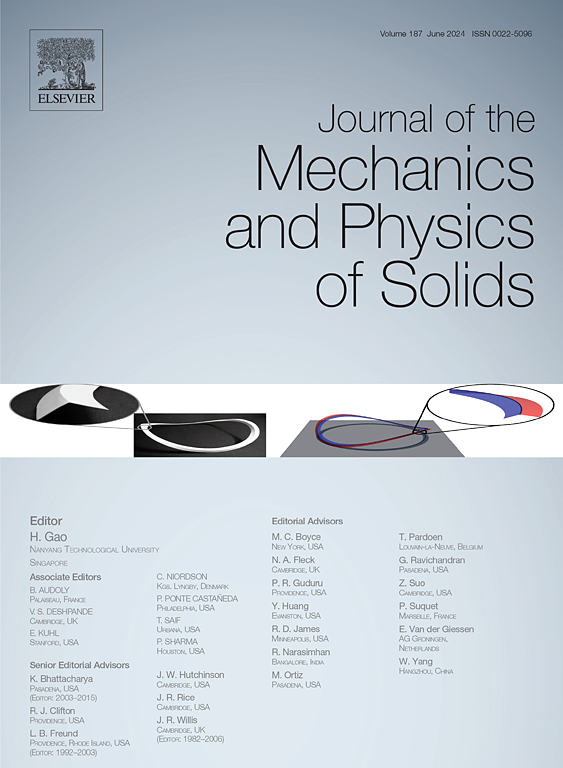软可压缩和不可压缩固体的大应变本构模型:广义各向同性和各向异性粘弹性
IF 6
2区 工程技术
Q2 MATERIALS SCIENCE, MULTIDISCIPLINARY
引用次数: 0
摘要
本文讨论了粘弹性材料大应变本构模型的一种新的现象学连续体公式。继Sidoroff(1974)、Lubliner(1985)、Bergström(1998)和Reese and Govindjee(1997)的开创性工作之后,该公式与其他现象学方法有一些共同的成分,包括变形梯度的乘法分解为粘性和弹性贡献,应变能密度的加性麦克斯韦式分解,以及一组运动内部状态变量及其相关演化规律的定义。我们的配方通过三个不同的新奇之处有别于其他最先进的方法。首先,回顾Bonet(2001)之前的工作,本文在应力型变量方面引入了热力学一致的线性速率型演化规律,类似于弹塑性中通常使用的返回映射算法,促进了两种非弹性本构模型之间的建模联系。从这个意义上说,所提出的粘弹性演化规律可以与经典塑性流动规律相识别。非常重要的是,通过构造证明了演化规律与热力学第二定律相容,并且在不可压缩粘弹性情况下,当使用非平衡应变能密度的新hookean型原型时,演化规律具有封闭解。此外,本文还展示了如何利用应力驱动耗散势的概念,直接构建更一般的非线性应力演化规律。其次,为了兼顾各向异性和热力学平衡,引入了一种框架无应力构形,方便了客观应变测度的定义。第三,通过考虑适当的结构张量,将方法从各向同性扩展到横向各向同性。该公式首先用于单个横向各向同性不变量贡献具有相应的闭型解的简单情况,然后直接推广到考虑第二个横向各向同性不变量,多族纤维,甚至更复杂的对称群。为了证明新框架的能力,由于VHB 4910聚合物在当前基于电活性聚合物的软机器人中使用,因此采用了八链长期应变能(长期)和新胡克应变能(非平衡)的特殊形式来描述其机械行为。在各种试验中,包括加载-卸载循环试验、单步松弛试验和多步松弛试验,发现计算机预测与现有实验数据吻合良好。最后,进行了双轴加载-卸载循环和松弛试验,以进一步展示各向异性场景下的性能。本文章由计算机程序翻译,如有差异,请以英文原文为准。
Large strain constitutive modelling of soft compressible and incompressible solids: Generalised isotropic and anisotropic viscoelasticity
This paper discusses a new phenomenological continuum formulation for the constitutive modelling of viscoelastic materials at large strains. Following pioneering works in Sidoroff (1974), Lubliner (1985), Bergström (1998) and Reese and Govindjee (1997), the formulation shares some common ingredients with other phenomenological approaches, including the multiplicative decomposition of the deformation gradient into viscous and elastic contributions, the additive Maxwell-type decomposition of the strain energy density, and the definition of a set of kinematic internal state variables with their associated evolution laws. Our formulation departs from other state-of-the-art methodologies via three distinct novelties. First, and revisiting previous work by Bonet (2001), the paper introduces a thermodynamically consistent linear rate type evolution law in terms of stress-type variables, which resembles the return mapping algorithm typically used in elastoplasticity, facilitating the modelling link between both inelastic constitutive models. In this sense, the proposed viscoelastic evolution law can be identified with a classical plastic flow rule. Very importantly, the evolution law is shown to be compatible with the second law of thermodynamics by construction and have a closed-form solution in the case of incompressible viscoelasticity when using a prototypical neo-Hookean type of non-equilibrium strain energy density. Moreover, the paper shows how using the concept of a stress-driven dissipative potential, more general non-linear type of stress evolution laws can be straightforwardly constructed. Second, to facilitate the joint consideration of anisotropy and thermodynamic equilibrium, a frame indifferent stress free configuration is introduced which facilitates the definition of objective strain measures. Third, the methodology is extended from isotropy to transverse isotropy via the consideration of the appropriate structural tensor. The formulation is first displayed for the simple case of a single transversely isotropic invariant contribution with corresponding closed-form solution, and then straightforwardly extended to the consideration of the second transversely isotropic invariant, multiple families of fibres, or even more complex symmetry groups. To demonstrate the capability of the new framework, a specialised form of the eight-chain long-term strain energy (long term) and a neo-Hookean strain energy (non-equilibrium) have been adopted for the description of the mechanical behaviour of VHB 4910 polymer, due to its use in current Electro-Active Polymers based soft robotics. Good agreement is found between in silico predictions and available experimental data on various tests, including loading–unloading cyclic tests, single-step relaxation tests and a multi-step relaxation test. Finally, biaxial loading–unloading cyclic and relaxation tests are presented to further showcase performance in anisotropic scenarios.
求助全文
通过发布文献求助,成功后即可免费获取论文全文。
去求助
来源期刊
CiteScore
9.80
自引率
9.40%
发文量
276
审稿时长
52 days
期刊介绍:
The aim of Journal of The Mechanics and Physics of Solids is to publish research of the highest quality and of lasting significance on the mechanics of solids. The scope is broad, from fundamental concepts in mechanics to the analysis of novel phenomena and applications. Solids are interpreted broadly to include both hard and soft materials as well as natural and synthetic structures. The approach can be theoretical, experimental or computational.This research activity sits within engineering science and the allied areas of applied mathematics, materials science, bio-mechanics, applied physics, and geophysics.
The Journal was founded in 1952 by Rodney Hill, who was its Editor-in-Chief until 1968. The topics of interest to the Journal evolve with developments in the subject but its basic ethos remains the same: to publish research of the highest quality relating to the mechanics of solids. Thus, emphasis is placed on the development of fundamental concepts of mechanics and novel applications of these concepts based on theoretical, experimental or computational approaches, drawing upon the various branches of engineering science and the allied areas within applied mathematics, materials science, structural engineering, applied physics, and geophysics.
The main purpose of the Journal is to foster scientific understanding of the processes of deformation and mechanical failure of all solid materials, both technological and natural, and the connections between these processes and their underlying physical mechanisms. In this sense, the content of the Journal should reflect the current state of the discipline in analysis, experimental observation, and numerical simulation. In the interest of achieving this goal, authors are encouraged to consider the significance of their contributions for the field of mechanics and the implications of their results, in addition to describing the details of their work.

 求助内容:
求助内容: 应助结果提醒方式:
应助结果提醒方式:


